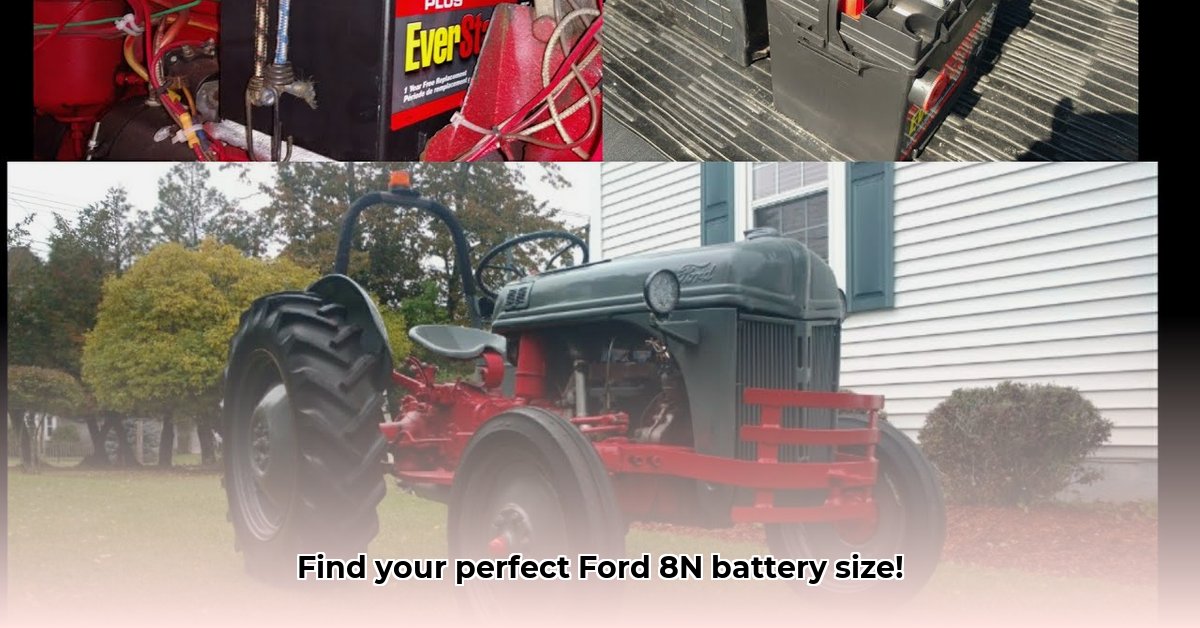
Finding the right battery for your classic Ford 8N tractor can be surprisingly tricky. This guide provides a step-by-step process, ensuring a safe and successful installation while maintaining (or adapting) your original battery cover. Let's get your 8N back in action! For additional 8N resources, check out this helpful website.
Measuring Your Battery Box: The Foundation of Success
Before purchasing a new battery, precisely measure your tractor's battery tray. Record the length, width, height, and the location of the battery terminals. Photographs are invaluable. Accurate measurements are crucial for a perfect fit and will prevent compatibility issues later. Don't skimp on this step!
Decoding Battery Groups: Understanding the Dimensions
You'll encounter "battery group sizes," such as Group 24 and Group 34. These numbers represent the battery's physical dimensions. A Group 34 battery is larger than a Group 24, offering potentially higher power capacity. However, a larger battery might not fit your existing battery tray. Less common sizes, like Group 140REXTJ, might require modifications to your battery tray or hold-downs. Consider the trade-offs between battery size and its compatibility with your existing setup.
Cold Cranking Amps (CCA): Power for Cold Starts
Cold Cranking Amps (CCA) indicate how much power your battery delivers in cold temperatures. Higher CCA ensures easier starts, especially in colder climates. The required CCA range depends on your location and usage. In milder climates, lower CCA might suffice, but colder climates require a significantly higher CCA rating. There is no single "correct" number; find the appropriate balance for your needs.
Choosing Your Battery: The Right Fit for Your 8N
Consider this simplified chart to guide your selection:
| Battery Tray Size | Climate | Recommended Battery Group | CCA Considerations |
|---|---|---|---|
| Small (fits Group 24) | Mild (above freezing) | Group 24 | Choose a Group 24 battery with sufficient CCA for your specific needs. |
| Small (fits Group 24) | Cold (below freezing) | Group 24 | Opt for a Group 24 battery with a higher CCA rating. |
| Large (fits Group 34) | Mild (above freezing) | Group 34 | Group 34 provides extra power reserve, a good option even in mild climates. |
| Large (fits Group 34) | Cold (below freezing) | Group 34 | Maximize cold-weather starting with a high CCA Group 34 battery. |
Remember: Always double-check the battery's dimensions against your measurements before purchasing.
Battery Installation: A Step-by-Step Guide
Safety is paramount! Wear safety glasses and gloves. Disconnect the negative (-) terminal first, then the positive (+).
- Preparation: Disconnect the battery terminals.
- Removal: Carefully remove your old battery; note its mounting and connections for later reference.
- Cleaning: Clean the battery tray and terminals.
- Installation: Securely mount the new battery, replicating the original configuration. Avoid improvising.
- Connections: Connect the positive (+) terminal, then the negative (-). Tighten securely.
Addressing the Original Battery Cover: Potential Compatibility Issues
The original battery cover is often the biggest hurdle. A new battery might not fit perfectly. You may need to slightly modify the cover, or find a replacement. Consider the trade-offs between maintaining originality and ease of installation.
Safety Precautions: Handling Batteries Responsibly
Sulfuric acid in batteries is corrosive. Wear protective gear. Work in a well-ventilated area. Avoid sparks or open flames. Dispose of old batteries properly at a recycling center.
Troubleshooting: Addressing Common Issues
- Slow Cranking: Insufficient CCA, weak battery. Consider a higher CCA battery.
- No Cranking: Check all connections, battery voltage, and the starter motor.
- Battery Dies Quickly: Potential parasitic drain (electrical drain when off). Consult a mechanic.
Choosing the correct battery is vital for your 8N's smooth operation. Remember: a proper fit is as important as power capacity. Have a productive farming season!
Key Takeaways:
- Accurate measurement is crucial for a proper fit.
- Consider CCA requirements based on your climate.
- Safety precautions are paramount during installation and handling.
- The original battery cover might require modification or replacement.